
Meet a woman who broke all the barriers to become a champion for civil rights: Constance Baker Motley lawyer, state senator, and federal judge. [1:52]
- Subject:
- Social Studies
- Material Type:
- Lesson Plan
- Provider:
- iCivics
- Date Added:
- 08/07/2023

Meet a woman who broke all the barriers to become a champion for civil rights: Constance Baker Motley lawyer, state senator, and federal judge. [1:52]

As an assistant attorney general in the Civil Rights Division of the Department of Justice, Burke Marshall played a key role in the federal government's efforts to desegregate the South. Representing the presidential administrations of John F. Kennedy and Lyndon B. Johnson, Marshall mediated conflicts between civil rights protesters and southern white officials. In this interview, Marshall recalls the 1961 Freedom Rides and the 1962 desegregation of the University of Mississippi.

This collection uses primary sources to explore school desegregation in Boston. Digital Public Library of America Primary Source Sets are designed to help students develop their critical thinking skills and draw diverse material from libraries, archives, and museums across the United States. Each set includes an overview, ten to fifteen primary sources, links to related resources, and a teaching guide. These sets were created and reviewed by the teachers on the DPLA's Education Advisory Committee.

A senior high lesson plan on segregation in schools.
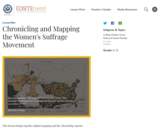
This lesson brings together digital mapping and the Chronicling America newspaper database as part of an inquiry into how and where the women's suffrage movement took place in the United States. Primary source newspaper articles published between 1911-1920 and maps from 1918-1920 are used to prompt student research into how women organized, the type of elections that women could participate in, and the extent to which the 19th Amendment transformed voting rights in the U.S.
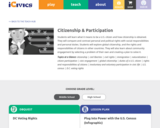
This is a full unit of study from iCivics, featuring multiple lesson plans with presentations, downloadable documents, and more. Students will learn what it means to be a U.S. citizen and how citizenship is obtained. They will compare and contrast personal and political rights with social responsibilities and personal duties. Students will explore global citizenship, and the rights and responsibilities of citizens in other countries. They will also learn about community engagement by selecting a problem of their own and creating a plan to solve it.
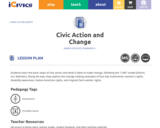
Students learn the basic steps of civic action and what it takes to make change, following the "I AM" model (Inform, Act, Maintain). Along the way, they explore the change-making examples of four key movements: women's rights, disability awareness, Native American rights, and migrant farm worker rights. LESSON OBJECTIVES: Explain how civic action can affect change *Explain how citizens communicate with public officials (protest, petition, sit-ins, etc.). *Compare and contrast views on a contemporary issue. *Describe opportunities for citizens to participate in the political process and to monitor and influence government. *Describe three steps involved in civic action: inform, act and maintain the message. *Discuss the movements for the following groups: women, the disabled, Native Americans and migrant workers.

Examine social media's influence in America's Civil Rights movement and its role in democratizing the media, in this video from Eyes on the Prize: Then and Now. Activists, including DeRay McKesson, use social media to support the work of social change protesters. Because communications are unmediated and occur in real time, McKesson says, social media can help build community. Tamika Mallory calls social media a powerful asset, enabling people who have never met before to share information and support one anothers efforts. Support materials are provided [2:35]

Discover ways in which systemic inequality persists today in the lives of people of color, women, and those living in both urban and rural areas, in this video from Eyes on the Prize: Then and Now. Many communities have been denied quality affordable housing, and a rapidly growing wealth gap disproportionately impacts communities of color and other ethnic minorities. While some progress has been made, one young activist states that skin color and where a child lives can predict whether he or she is more likely to end up in prison or in a career. Support materials are provided. [2:19]

While students today may think of the Civil Rights Movement as part of the distant past, it's clear that many of the problems that fueled that fight are still with us. This collection of videos, documents, and primary sources lends context to the events and leaders that defined the Civil Rights Movement's first three decades (1954-1985). These resources also capture the issues and activists involved in the struggle today - those making headlines, stirring debate, and trending on social media. This collection can be used to support teaching the content featured in the PBS rebroadcast of the groundbreaking Civil Rights documentary series, Eyes on the Prize. This Collection includes: Video (83), Document (8), Interactive (1), Audio (2), Media Gallery (9), Lesson Plan (1) for Grades 9-12, 3-5, 6-8
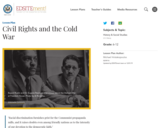
This lesson plan attempts to dissolve the artificial boundary between domestic and international affairs in the postwar period to show students how we choose to discuss history.
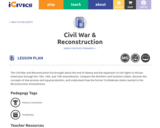
The Civil War and Reconstruction Era brought about the end of slavery and the expansion of civil rights to African Americans through the 13th, 14th, and 15th Amendments. Compare the Northern and Southern states, discover the concepts of due process and equal protection, and understand how the former Confederate states reacted to the Reconstruction Amendments. LESSON OBJECTIVES: Identify the division of the U.S. at the outbreak of the Civil War. *Describe the expansion of civil rights and liberties in the Civil War/Reconstruction Period. *Explain the purposes of the due process and equal protection clauses of the 14th Amendment. *Identify the different perspectives on slavery during the Civil War period. *Determine the differences between the Presidential and Congressional plans for Reconstruction.

Making Evidence-Based Claims ELA/Literacy Units empower students with a critical reading and writing skill at the heart of the Common Core: making evidence-based claims about complex texts. These units are part of the Developing Core Proficiencies Program. This unit develops students' abilities to make evidence-based claims through activities based on a close reading of the Nobel Peace Prize Speeches of Rev. Dr. Martin Luther King, Jr. and President Barack Obama.

Making Evidence-Based Claims ELA/Literacy Units empower students with a critical reading and writing skill at the heart of the Common Core: making evidence-based claims about complex texts. These units are part of the Developing Core Proficiencies Program. This unit develops students' abilities to make evidence-based claims through activities based on a close reading of the first chapter of W.E.B. Du Bois' The Souls of Black Folk.
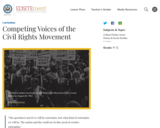
When most people think of the Civil Rights Movement in America, they think of Martin Luther King, Jr. Delivering his "I Have a Dream" speech on the steps of the Lincoln Memorial in 1963. But "the Movement" achieved its greatest results due to the competing strategies and agendas of diverse individuals.

This site from the Cornell University Law School provides an overview of constitutional law as it applies in the United States, with links to additional information.
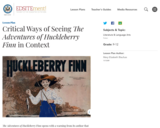
Huckleberry Finn opens with a warning from its author that misinterpreting readers will be shot. Despite the danger, readers have been approaching the novel from such diverse critical perspectives for 120 years that it is both commonly taught and frequently banned, for a variety of reasons. Studying both the novel and its critics with an emphasis on cultural context will help students develop analytical tools essential for navigating this work and other American controversies. This lesson asks students to combine internet historical research with critical reading. Then students will produce several writing assignments exploring what readers see in Huckleberry Finn and why they see it that way.
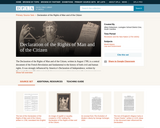
This collection uses primary sources to explore the Declaration of the Rights of Man and of the Citizen. Digital Public Library of America Primary Source Sets are designed to help students develop their critical thinking skills and draw diverse material from libraries, archives, and museums across the United States. Each set includes an overview, ten to fifteen primary sources, links to related resources, and a teaching guide. These sets were created and reviewed by the teachers on the DPLA's Education Advisory Committee.

Read a brief overview of the history behind this executive order that integrated the segregated military and then read a copy of the complete original text.

The Social Issues Collection is an image database of the Western United States and the Pacific Northwest region. The collection covers a variety of political and social topics, from women's issues, government, labor organizations such as the Industrial Workers of the World, utopian colonies, ethnic groups such as Chinese Americans, Japanese Americans and Scandinavians, and social and leisure activities including mountaineering, camping and boating. Images document, in addition, the World War II Japanese Internment camps of the Minidoka Relocation Center and the Puyallup Assembly Center known as Camp Harmony.